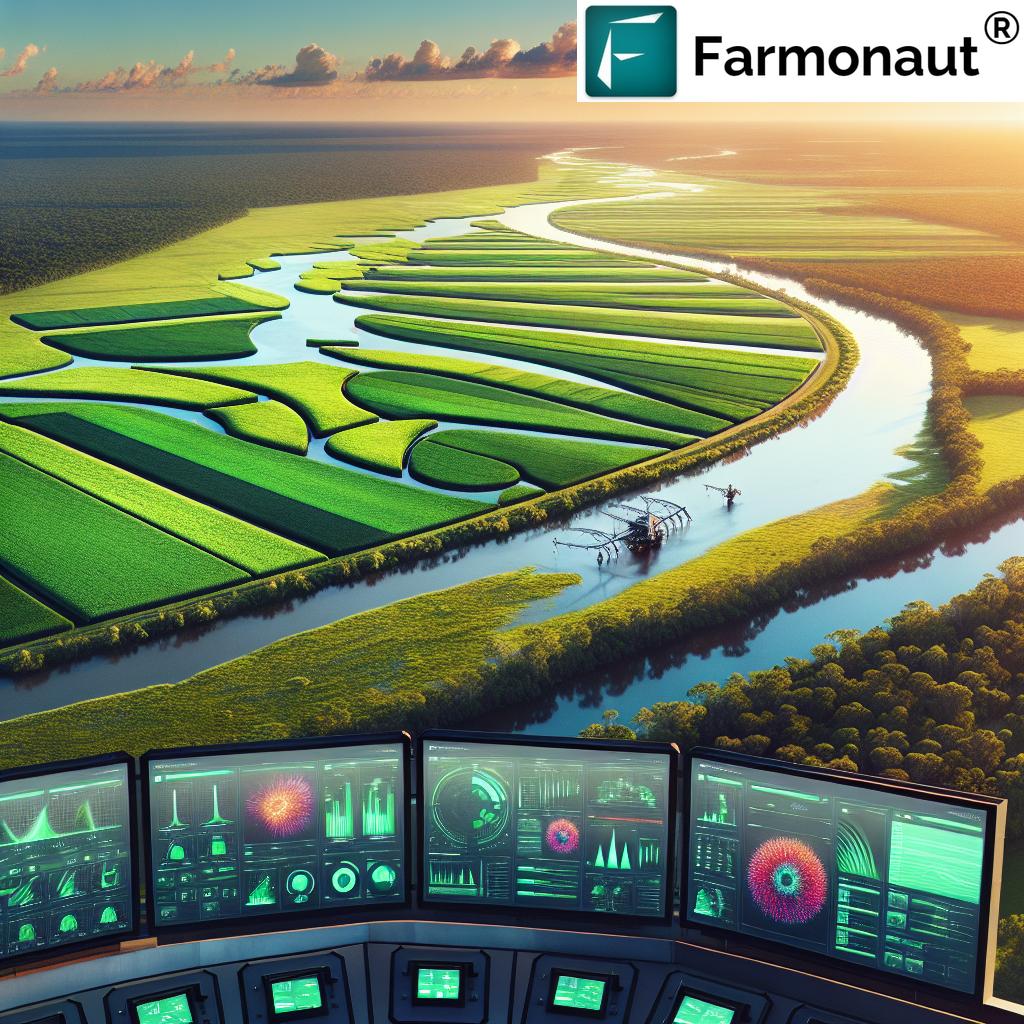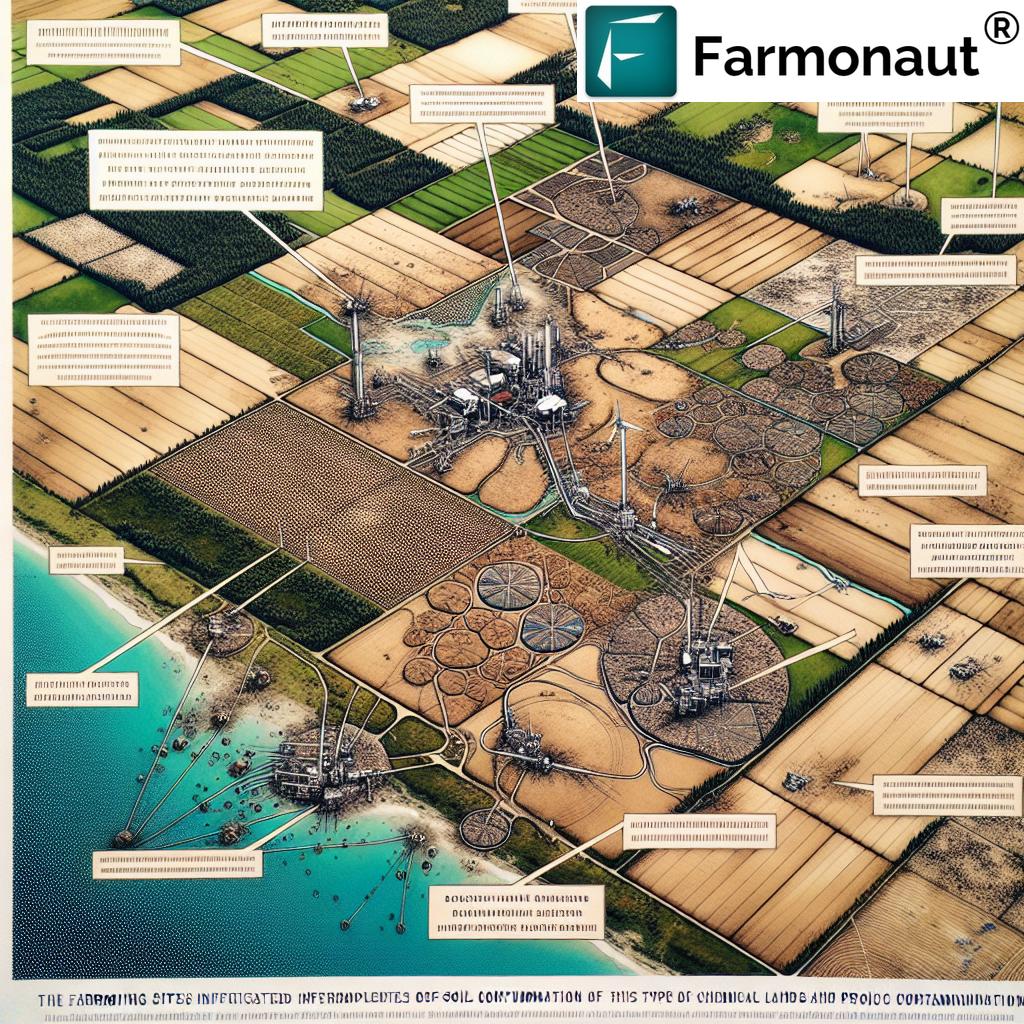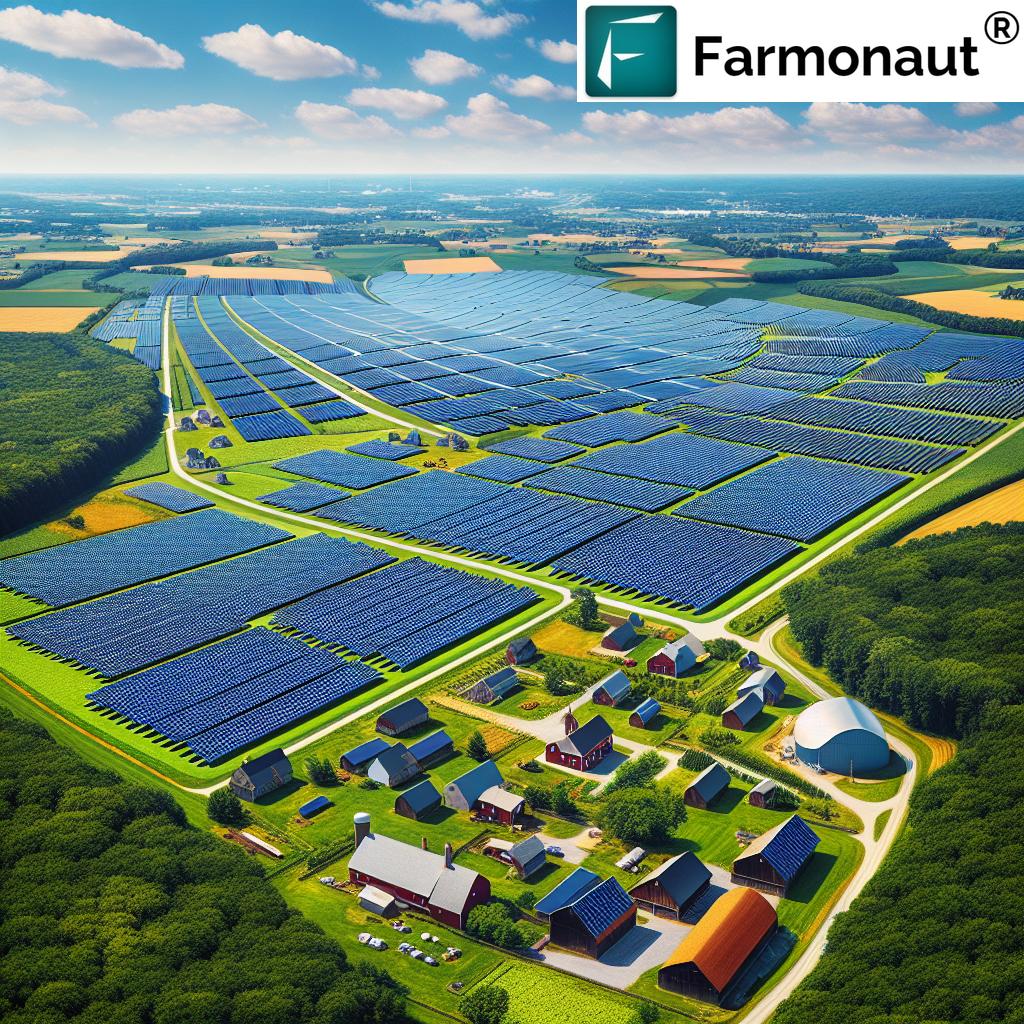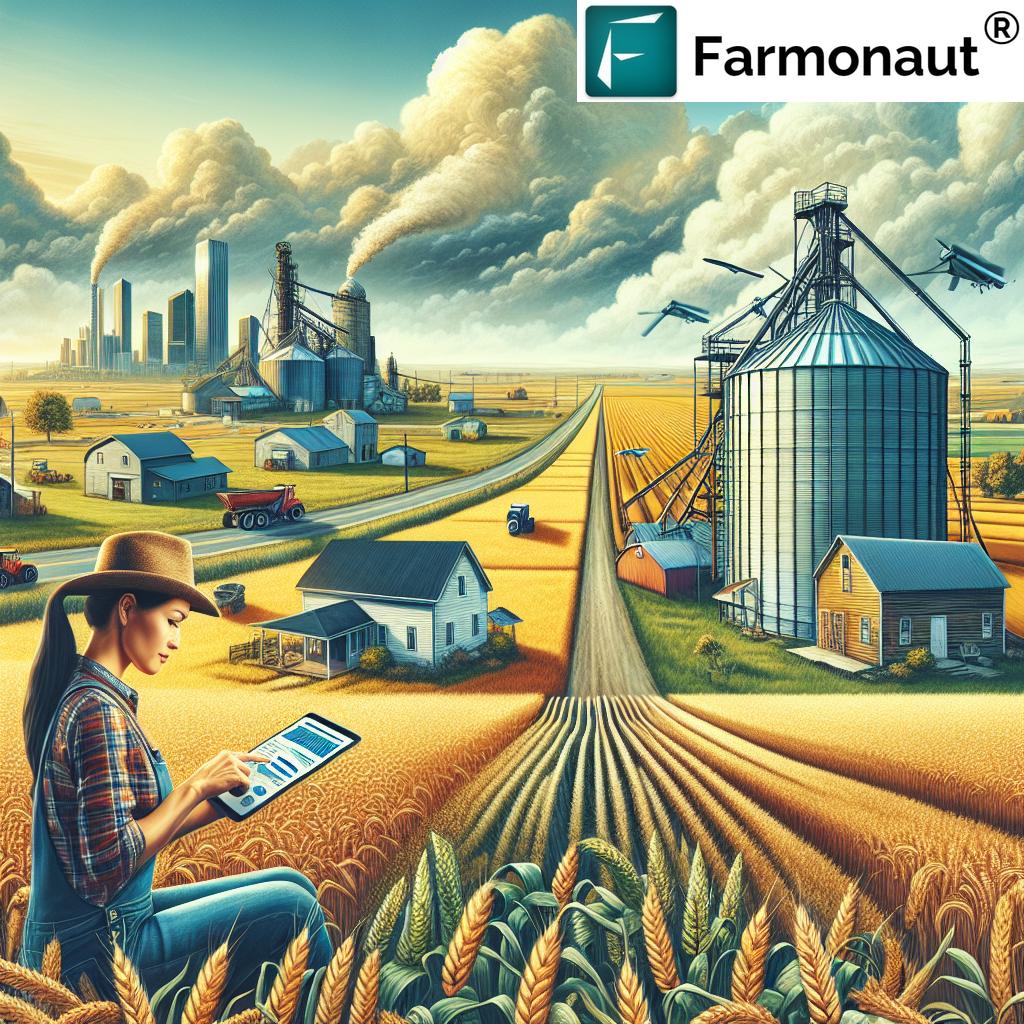United States Agriculture Technology: Urban & Sustainable Innovations
“By 2025, U.S. urban farms using AI are projected to increase crop yields by up to 30%.”
Table of Contents
- The Future Landscape: How Technology Agriculture is Transforming the United States
- Precision Agriculture at the Forefront: AI, IoT, and Big Data Innovations
- Robotics and Automation: Driving Efficiency and Sustainability on American Farms
- United States Urban Agriculture: Controlled Environments for Sustainable Growth
- Smart Forestry: Sustainable Management with Advanced Technologies
- The Integration of Data, Blockchain, and Traceability
- Satellite Innovations for 2025: Farmonaut’s Role in Precision Farming
- Comparative Innovations Table: Key Technologies in U.S. Agriculture Technology
- Technology Agriculture 2025 and Beyond: Future-Proofing U.S. Food Systems
- Frequently Asked Questions
- Subscribe for Advanced Agriculture Solutions
The Future Landscape: How Technology Agriculture is Transforming the United States
The landscape of agriculture in the United States is being rapidly transformed by technology. As we move into 2025, United States agriculture technology epitomizes the convergence of artificial intelligence (AI), robotics, the Internet of Things (IoT), advanced data analytics, and blockchain for tracking supply chains. From precision farming to urban agriculture and smart forestry, the integration of technology for agriculture is reshaping how food is produced, resources are managed, and supply chains are optimized.
In an era of climate variability, water scarcity, and rising demand for organic and sustainable practices, it’s no surprise we are witnessing a profound shift in traditional farming methods. The integration of innovations across the sector is fostering not only increased yields and resource efficiency, but also promoting environmental stewardship and transparency—a transformative approach critical for the future of American food systems.
Let us explore these emerging technologies and innovations in United States agriculture technology that are poised to redefine the efficiency, sustainability, and productivity of farms and urban growing spaces in 2025 and beyond.
Precision Agriculture at the Forefront: AI, IoT, and Big Data Innovations
Precision agriculture remains firmly at the forefront of United States agriculture technology. The integration of AI, IoT, and big data analytics represents a significant step forward—positioning the sector for a productive and sustainable future.
How AI and Analytics Are Powering Smarter Decisions
- AI-powered sensors and drones now collect real-time data on soil health, crop growth, and weather conditions.
- Algorithms analyze satellite imagery to detect pest infestations, identify nutrient deficiencies, and even predict optimal harvest periods.
- These advanced technologies enable farmers to make data-driven decisions, reducing inputs like water, fertilizers, and pesticides—while maximizing yields and minimizing waste.
For example, deploying AI-driven satellite imagery allows farmers to spot pest infestations early, apply targeted interventions, and promote sustainable practices by reducing environmental impact.
We at Farmonaut recognize the value of these innovations. By delivering multispectral satellite images, our platform empowers farmers to receive actionable AI-based advisory for irrigation, fertilizer, and pest management. This results in optimized yields and resource savings—making large-scale farm management both accessible and affordable.
Key Benefits of AI and Big Data in Precision Agriculture
- Maximized Yields: Timely and tailored crop management improves output
- Efficient Resource Use: Targeted application of water, fertilizers, and pesticides
- Disease and Pest Detection: Early interventions reduce losses and chemical usage
- Labor Efficiency: Automation of data collection and actionable insights
- Environmental Sustainability: Minimizing inputs lessens environmental impact
Farmonaut’s Jeenvn AI advisory system integrates these technologies for real-time, custom insights at the fingertips of US farmers. Learn more about our API for AI-driven data: Farmonaut API (Developer Docs).
Environmental & Economic Impact of Precision Technologies
These data-centric approaches make sustainable agriculture practical for a broad range of farms in the United States. They allow for improved water management, reduced chemical usage, and better financial returns—with the added benefit of decreasing the food system’s environmental footprint.
Robotics and Automation: Driving Efficiency and Sustainability on American Farms
“Over 60% of new U.S. agricultural robots in 2025 will be deployed in sustainable urban farming systems.”
The deployment of robotics and automation technology is shaping a new era for agriculture in the United States. These solutions are increasingly important for addressing labor shortages and improving the accuracy and efficiency of critical farming tasks.
Autonomous Machinery: Tractors, Harvesters, and Planters
- Autonomous tractors can plant and till fields with greater precision, 24/7 operation, and minimal fuel waste.
- Robotic harvesters use AI vision systems to pick crops at optimal ripeness, helping to reduce losses and maximize quality.
- Robotic planters and seeders provide uniform planting depth and spacing, resulting in predictable and healthy crop growth conditions.
Robotic Weeders and Organic Farming Practices
Of particular interest are robotic weeders—autonomous machines that selectively remove weeds without herbicides. These systems use machine vision to distinguish weeds from crops, providing:
- Lower chemical usage
- Reduced weed competition and better yields
- Promotion of organic and environmentally sustainable practices
Labor Shortages and Productivity Gains
With an aging agricultural workforce and ongoing labor shortages, American farms are turning to automated solutions. These tools can perform repetitive and strenuous tasks with a high level of accuracy, freeing up human expertise for strategic management and problem solving. The net result is both cost savings and an increase in food system resilience.
Automation Across the Supply Chain
Robotics and automation are not limited to the field. They extend into supply chain logistics, including the tracking of harvests, storage optimization, and timely delivery to distributors and consumers. Integration with digital farm management platforms amplifies these benefits, enabling real-time decisions and predictive planning based on real-world data.
Farmonaut’s Platform: Optimizing Fleet and Resource Management
We provide fleet and resource management tools for agribusinesses across the United States. These capabilities help reduce operational costs by optimizing vehicle usage, ensuring equipment safety, and streamlining agricultural machinery management. Explore more about Fleet Management Solutions for your agriculture operation.
United States Urban Agriculture: Controlled Environments for Sustainable Growth
As urban populations in the United States continue to grow, urban agriculture technology is evolving to meet the demand for fresh, local produce while reducing the environmental impact of food transportation. Urban and controlled-environment agriculture (CEA) are making significant strides, reshaping the landscape of city food systems.
Controlled-Environment Techniques: Vertical Farming, Hydroponics, Aeroponics
- Vertical farms stack crops on shelves indoors, multiplying production in limited urban spaces.
- Hydroponics and aeroponics grow food using nutrient-rich water, minimal soil, and highly controlled climates.
- LED lighting systems are optimized for photosynthesis, resulting in fast and healthy crop growth.
- Automated irrigation and nutrient delivery reduce water usage by up to 95% compared to traditional field agriculture.
Key Advantages of United States Urban Agriculture Technology
- Year-round, reliable harvests
- Reduced land and water requirements
- No need for pesticides or herbicides—supporting organic production
- Close proximity to urban consumers—minimizing transportation emissions and reducing food waste
Urban Agriculture Systems and Community Engagement
Technology is fostering new forms of community engagement and food distribution. Apps and online platforms now connect urban growers directly with consumers, restaurants, and local distributors, making food systems more resilient and adaptive to local needs.
How Farmonaut Supports Urban Agriculture Technology
Our platform delivers timely crop health monitoring and predictive analytics tools that are perfectly suited for precision urban agriculture. Through real-time satellite data and AI-driven recommendations, urban farmers can optimize growth conditions and sustainability.
Sustainability and Climate-Smart Urban Food Systems
- Reducing water waste and energy consumption through optimized, automated systems
- Encouraging biodiversity via polyculture cropping and pollinator-friendly spaces
- Improving resilience to climate shocks and fluctuations in the global food supply
Interested in tracking your urban farm’s carbon footprint? Discover Farmonaut’s Carbon Footprinting Tool for reliable measurement and actionable advice to lower your environmental impact.
Smart Forestry: Sustainable Management with Advanced Technologies
Sustainable forestry in the United States is no longer just about planting or harvesting trees—it now leverages advanced digital and imaging technologies to support ecosystem health, biodiversity, and climate goals.
Drones, LiDAR, and AI: Monitoring & Managing Forest Resources
- Drones equipped with multispectral cameras provide real-time data on forest health, pest infestations, and fire risks.
- LiDAR scanning measures tree growth, canopy coverage, and biomass for sustainable management of timber resources.
- AI algorithms analyze environmental conditions and predict potential threats, allowing targeted conservation interventions to preserve biodiversity.
Fire Risk Management and Conservation
Smart forestry management is essential for reducing wildfire risk and managing protected areas. Satellite monitoring allows for early fire detection and effective resource allocation during emergencies.
If you are involved in forest crop management or require advisory services, check out how Farmonaut’s Crop Plantation & Forest Advisory Tools can help track, monitor, and optimize forestry operations using satellite and AI technology.
Promoting Biodiversity and Sustainable Timber Supply Chains
Digital tools also ensure the traceability of timber, verifying sustainable origins and reducing illegal logging. Blockchain-based systems are increasingly incorporated to create transparent, trustworthy supply chains, meeting environmentally conscious consumer demand.
Read about blockchain-powered product traceability for timber and produce: Farmonaut Traceability.
The Integration of Data, Blockchain, and Traceability
The proliferation of digital data collection, AI analytics, and blockchain traceability solutions is making supply chains more efficient and transparent across the entire agriculture industry in the United States—urban, rural, or forestry-based.
Blockchain: Ensuring Secure and Transparent Supply Chains
- Blockchain-based traceability systems verify the origin, quality, and journey of food products—critical for compliance, consumer trust, and premium pricing.
- Digital records—impossible to falsify—help fight food fraud and encourage sustainable farming practices by tracking every step from farm to fork.
- For corporate clients in food and textile supply chains, blockchain enhances brand reputation and supports environmental/sustainability claims in global markets.
APIs and Application Integration for Smarter Management
- Application interfaces (APIs) enable seamless integration of farm and supply chain data with food processors, retailers, and financial institutions.
- APIs power real-time crop monitoring, satellite verification for crop loans, and insurance processes—streamlining access to agriculture finance and risk management.
Secure Financing with Satellite and Blockchain Verification
Today’s agriculture finance ecosystem is evolving. We offer satellite-based verification for crop loan and insurance processes—reducing fraud, expediting approvals, and improving access to capital for U.S. farmers. Explore crop loan and insurance solutions at Farmonaut Crop Loan & Insurance.
These integrations help scale up technology-driven agriculture for individuals, agribusinesses, governments, and NGOs across the United States.
Satellite Innovations for 2025: Farmonaut’s Role in Precision Farming
We at Farmonaut play a vital role in expanding access to precision agriculture for all scale farmers—including those in the United States. Here’s how our technologies are shaping the future of food systems and urban agriculture in 2025 and beyond:
- Satellite-Based Crop Health Monitoring: Using multispectral satellite imagery, we provide detailed NDVI analysis, soil moisture data, and insights on crop health conditions. This information helps U.S. farmers make informed decisions about irrigation, pest management, and fertilizer use with fewer resources and lower costs.
- AI-Powered Advisory Systems: Our Jeevn AI delivers real-time, personalized advisory based on weather and satellite data—improving decision-making, increasing yields, and reducing carbon footprints for American farms.
- Blockchain-Driven Traceability: Farmonaut’s blockchain features enable secure traceability of produce and timber in supply chains, supporting efforts to combat food fraud and guarantee sustainability standards in the United States.
- Resource and Fleet Management: Our tools enable agribusinesses to efficiently manage logistics and reduce operational costs—vital for expanding sustainable practices across the nation.
- Environmental Compliance and Carbon Tracking: By providing live carbon footprinting data, we help American farmers measure, monitor, and actively reduce the environmental impact of their operations.
Our platform, available through Android, iOS, web app, and API, is designed to fit seamlessly into any modern farm operation. Learn more about Farmonaut’s mission and solutions: Farmonaut Official Website.
Comparative Innovations Table: Key Technologies in U.S. Agriculture Technology
Technology Agriculture 2025 and Beyond: Future-Proofing U.S. Food Systems
By 2025 and beyond, United States agriculture technology epitomizes a new era in food production—a period defined by the convergence of AI, robotics, IoT, data analytics, and sustainable practices. Technology-driven initiatives are amplifying efficiency, traceability, and resilience at every node, from farms and forests to urban community gardens.
Digital Twins and Simulation
- Advanced modeling creates virtual replicas of real farms (digital twins), allowing for experimentation with planting schedules, irrigation, and crop rotations before any field changes occur.
- This approach reduces risk and maximizes yields while conserving resources.
Biotechnology and Gene Editing
- Breakthroughs in gene editing, such as CRISPR, are enabling the development of climate-resilient and nutrient-rich varieties.
- These technologies support American agriculture’s capacity to adapt to climate change and nutritional needs.
Connectivity: The Role of 5G and Rural Broadband
- Expansion of rural broadband and 5G networks empowers U.S. farmers with reliable, real-time data and remote monitoring tools—closing the digital divide.
- Enhanced connectivity allows for automation, machine-to-machine communication, and instantaneous decision-making.
A Sustainable, Equitable Vision
The vision for technology agriculture in the United States is clear: to advance sustainable and productive food systems that reduce environmental impact, increase equity, and bolster resilience for future generations.
- Traditional practices are evolving to become smarter and more connected.
- Supply chains are optimized for both profit and planet.
- Sustainable urban agriculture is central to city resiliency.
- AI, robotics, and data analytics unlock new frontiers in yield, efficiency, and sustainability.
With the rapid pace of innovation, the United States stands ready to lead the world in sustainable, technology-driven agriculture—serving not only its own citizens, but also contributing to global food security.
Frequently Asked Questions: United States Agriculture Technology
What is precision agriculture, and why is it important for U.S. farmers in 2025?
Precision agriculture refers to the use of AI, sensors, drones, and data analytics to monitor and manage crops, soil, and resources at a granular level. For U.S. farmers, this means improved yields, reduced resource waste, and minimized environmental impact—key for staying competitive and sustainable in 2025.
How does robotics help with sustainable farming?
Robotics, such as autonomous tractors and robotic weeders, automate time-consuming tasks with high precision. This not only tackles labor shortages but also enables more accurate planting, weeding, and harvesting—reducing chemical inputs and promoting organic farming methods.
How is urban agriculture technology evolving in the United States?
United States urban agriculture is embracing vertical farming, hydroponics, and automation. Technology enables year-round production, maximum land and water efficiency, and local supply for cities—reducing food transportation’s carbon footprint and supporting community food security.
What role does Farmonaut play in the transformation of U.S. agriculture?
We provide satellite-based crop health monitoring, AI advisory, blockchain traceability, resource management, and carbon tracking—all via web, mobile app, and API. Our platform helps make precision agriculture affordable and accessible for U.S. farmers, agribusinesses, and supply chain stakeholders.
Can U.S. farmers improve their supply chain transparency using blockchain?
Yes! Blockchain offers secure and transparent supply chains, helping verify the origin of produce or timber, combat food fraud, and support sustainable certifications. Learn more about product traceability here.
Are there solutions to help with crop loans, insurance, or government subsidies?
Absolutely! Farmonaut offers satellite-based verification for crop loan and insurance applications. This technology simplifies documentation, reduces fraud, and improves risk assessment—benefiting U.S. farmers and institutions. Explore satellite solutions for insurance and finance here.
Subscribe for Advanced Agriculture Solutions
Experience the power of technology agriculture with Farmonaut! Whether you are a farmer, agribusiness, or urban grower, get access to the best satellite-driven, AI-powered, and precision tools for sustainable, productive results.
Download the Farmonaut App or API
For API access and developer integration, visit:
Farmonaut API Page &
API Developer Docs
Conclusion
The landscape of United States agriculture technology is undergoing a remarkable transformation as we approach 2025. Driven by the integration of AI, robotics, IoT, and satellite technologies, American agriculture is becoming more efficient, sustainable, and resilient than ever before.
Through our innovative, data-driven solutions, Farmonaut remains committed to supporting the productive, sustainable, and transparent food systems required for the future. Whether in smart cities, open fields, or managed forests, United States agriculture technology is better equipped than ever to meet the challenges of tomorrow.
Join us in building a sustainable agricultural future—powered by technology and data, for farmers, businesses, and consumers across the nation.













